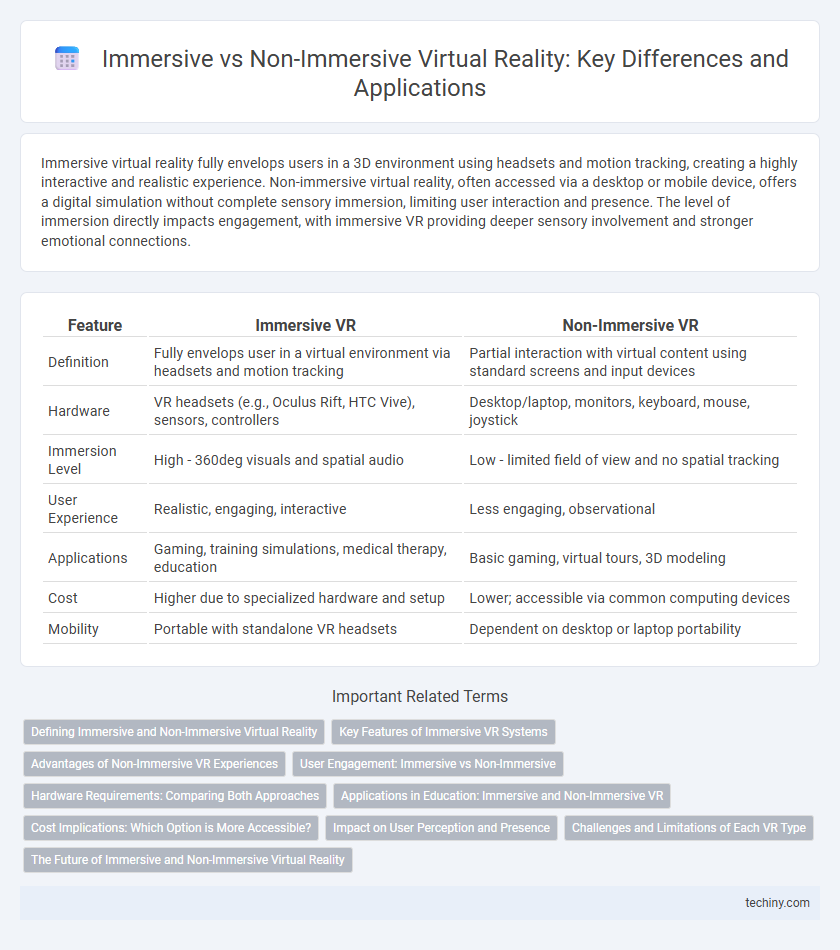Immersive virtual reality fully envelops users in a 3D environment using headsets and motion tracking, creating a highly interactive and realistic experience. Non-immersive virtual reality, often accessed via a desktop or mobile device, offers a digital simulation without complete sensory immersion, limiting user interaction and presence. The level of immersion directly impacts engagement, with immersive VR providing deeper sensory involvement and stronger emotional connections.
Table of Comparison
| Feature | Immersive VR | Non-Immersive VR |
|---|---|---|
| Definition | Fully envelops user in a virtual environment via headsets and motion tracking | Partial interaction with virtual content using standard screens and input devices |
| Hardware | VR headsets (e.g., Oculus Rift, HTC Vive), sensors, controllers | Desktop/laptop, monitors, keyboard, mouse, joystick |
| Immersion Level | High - 360deg visuals and spatial audio | Low - limited field of view and no spatial tracking |
| User Experience | Realistic, engaging, interactive | Less engaging, observational |
| Applications | Gaming, training simulations, medical therapy, education | Basic gaming, virtual tours, 3D modeling |
| Cost | Higher due to specialized hardware and setup | Lower; accessible via common computing devices |
| Mobility | Portable with standalone VR headsets | Dependent on desktop or laptop portability |
Defining Immersive and Non-Immersive Virtual Reality
Immersive virtual reality (VR) delivers a fully enveloping experience by using head-mounted displays and spatial audio to create a convincing sense of presence within a digital environment. Non-immersive VR, often accessed through standard monitors or screens, offers interactive 3D experiences without fully surrounding the user, limiting the sensation of immersion. The distinction relies on sensory engagement level, with immersive VR providing comprehensive sensory input and non-immersive VR delivering partial or windowed interaction with virtual worlds.
Key Features of Immersive VR Systems
Immersive VR systems feature head-mounted displays (HMDs) that provide 360-degree field of view and stereoscopic visuals for realistic depth perception. These systems incorporate spatial audio, motion tracking sensors, and haptic feedback devices to enhance user interaction and presence within the virtual environment. High refresh rates and low latency optimize fluid motion rendering, reducing motion sickness and increasing the sense of immersion compared to non-immersive VR setups.
Advantages of Non-Immersive VR Experiences
Non-immersive VR experiences offer greater accessibility by requiring only standard devices like desktop computers or smartphones, reducing hardware costs and complexity. These experiences enhance user comfort by minimizing motion sickness and physical strain often associated with fully immersive VR headsets. Non-immersive VR supports collaborative environments and easy integration with everyday tasks, making it ideal for education, training, and remote work applications.
User Engagement: Immersive vs Non-Immersive
Immersive virtual reality (VR) creates a fully encompassing environment using headsets and motion tracking, significantly enhancing user engagement by enabling natural interaction and presence within digital worlds. Non-immersive VR relies on standard displays and limited input devices, resulting in lower engagement as users remain aware of the physical surroundings and experience less sensory involvement. Studies show immersive VR can increase user attention, emotional connection, and retention compared to non-immersive setups, making it ideal for training, gaming, and therapeutic applications.
Hardware Requirements: Comparing Both Approaches
Immersive virtual reality systems require advanced hardware including VR headsets with high-resolution displays, motion sensors, and powerful graphics processing units (GPUs) to deliver fully interactive, 3D environments. Non-immersive VR, often experienced through standard monitors and basic input devices, demands significantly less computational power and peripherals. The substantial hardware investment in immersive VR supports enhanced spatial tracking and realistic interactions, contrasting with the accessibility and lower cost of non-immersive setups.
Applications in Education: Immersive and Non-Immersive VR
Immersive VR delivers fully interactive, 3D environments that enhance experiential learning by simulating real-world scenarios, particularly beneficial in medical training and engineering education. Non-immersive VR, accessed via desktops or mobile devices, supports conceptual understanding and collaborative learning through virtual labs and 3D modeling tools without requiring specialized hardware. Both types improve engagement and retention, with immersive VR offering a deeper sensory experience and non-immersive VR enabling broader accessibility in educational settings.
Cost Implications: Which Option is More Accessible?
Immersive virtual reality systems typically require higher upfront costs due to advanced hardware like VR headsets, motion sensors, and dedicated high-performance computers, making them less accessible for average consumers. Non-immersive VR, using standard screens and less specialized equipment, offers a more affordable entry point, reducing financial barriers for schools, small businesses, and casual users. Ongoing maintenance and content development expenses also tend to be lower for non-immersive setups, enhancing their overall cost-effectiveness and accessibility.
Impact on User Perception and Presence
Immersive virtual reality (VR) technologies significantly enhance user perception by creating a fully enveloping environment through head-mounted displays and motion tracking, fostering a strong sense of presence and realism. Non-immersive VR, typically experienced via standard screens, offers limited sensory input, resulting in reduced spatial awareness and lower psychological involvement. The level of immersion directly correlates with users' emotional engagement, cognitive processing, and their ability to perceive virtual scenarios as authentic experiences.
Challenges and Limitations of Each VR Type
Immersive virtual reality demands high-performance hardware and can cause motion sickness or disorientation due to sensory mismatch, limiting longer usage sessions. Non-immersive VR suffers from a lack of full sensory engagement, reducing presence and emotional impact while relying heavily on conventional input devices like keyboards and mice. Both VR types face content development challenges, with immersive VR requiring complex 3D modeling and interactivity, whereas non-immersive VR struggles with creating compelling, engaging experiences within limited sensory input.
The Future of Immersive and Non-Immersive Virtual Reality
The future of immersive virtual reality (VR) is driven by advances in high-resolution displays, realistic haptic feedback, and AI-powered environmental interactions, enabling fully sensory and interactive experiences. Non-immersive VR will continue to evolve through improved graphics and accessibility on conventional devices like PCs and smartphones, making virtual experiences more mainstream and integrated with daily activities. Emerging technologies such as 5G connectivity and cloud computing will accelerate the convergence of immersive and non-immersive VR, expanding applications in education, healthcare, and entertainment.
Immersive vs Non-immersive Infographic

 techiny.com
techiny.com